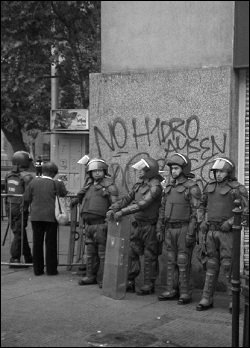In Chile, Explaining Massive Protests Entails Remembering the Past
In Chile, Explaining Massive Protests Entails Remembering the Past
Let’s start with the numbers. On May 28, an estimated twenty thousand people flooded into downtown Santiago and marched on the presidential palace to protest the HidroAysén project, a plan to build a series of hydroelectric dams on two of Chilean Patagonia’s most iconic rivers. The peaceful protest was a welcome relief to organizers after a forty-thousand-person march in Santiago a week earlier led to fifty-three arrests and outbreaks of violence. The images of demonstrators launching Molotov cocktails and destroying private property had been broadcast alongside footage of riot police confronting marchers. Since May, protesters and police have clashed in at least twenty-seven cities. At this writing in early summer, there are few signs that the nationwide movement is waning, as protests continue to attract thousands of Chileans to the streets. Meanwhile, the administration of President Sebastián Piñera has voiced support for the estimated $10 billion project, a private venture headed by two private-sector partners, a European conglomerate and a Chilean electricity giant. Though HidroAysén was temporarily stalled by a Court of Appeals ruling, the Chilean Supreme Court recently found in favor of HidroAysén, and the project continues to move forward. Perhaps the most telling and relevant statistics of all: 74 percent of Chilean citizens oppose HidroAysén, yet 72 percent believe that the project will be completed anyway, according to a May 2011 survey.

Protests numbering in the tens of thousands are noteworthy in their own right, but what makes these even more exceptional is that the entire country only has seventeen million people. A protest on that scale in the United States would number roughly 730,000 participants. The sheer size, breadth, and duration of this movement are extraordinary for Chile, paralleled only by those protests that called for an end to the rule of Augusto Pinochet.
To understand the events that led up to this point, it’s important to remember that Chile is in a position familiar to many larger developing countries. Much like China, India, and Brazil, Chile is seeking new energy sources to meet rising demand, especially for its large mining sector. But Chile’s options are limited for a few key reasons, first and foremost being its geography. Chile sits above the intersection of the Nazca and South American tectonic plates; along with its spectacular coastline and abundant fishing waters comes the constant danger of earthquakes and tsunamis. The possibility, however remote, that seismic activity could cause a disaster severely complicates nuclear power efforts, and in the wake of the Fukushima nuclear power station meltdown, there is even less political or public appetite to pursue nuclear energy.
Second, several efforts to build fossil-fuel-burning plants around the country have been thw...
Subscribe now to read the full article
Online OnlyFor just $19.95 a year, get access to new issues and decades' worth of archives on our site.
|
Print + OnlineFor $35 a year, get new issues delivered to your door and access to our full online archives.
|






